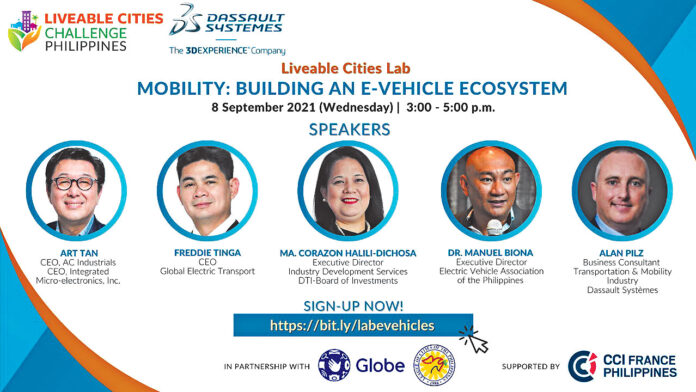The EV benefits are many, but incentives have to keep pace
TO BE HONEST, there’s now more than just a whiff of inevitability when it comes to the adoption — never mind the arrival, as they’re already here — of electric vehicles (EVs).
The Liveable Cities Challenge (LCC) and Dassault Systèmes, in partnership with the League of Cities of the Philippines and Globe Telecom, and with the support of the French Chamber of Commerce and Industry in the Philippines, staged another webinar that aimed to “equip cities with knowledge and insights for designing better solutions for their communities through the sharing of best practices.”
Already the eighth installment of a series this year, the most recent one last Wednesday was dubbed “Mobility: Building an E-vehicle Ecosystem,” which zeroed in on “the potential and benefits of e-vehicles as an alternative mode of transport in cities.”
Featured speakers in the online event included AC Industrials and Integrated Microelectronics, Inc. CEO Art Tan; Global Electric Transport CEO (and former Taguig City Mayor) Freddie Tinga; Electric Vehicle Association of the Philippines Executive Director Manny Biona; Dassault Systèmes Business Consultant for Transportation and Mobility Industry Alan Pilz; and Department of Trade and Industry-Board of Investments Executive Director of Industry Development Services Ma. Corazon Halili-Dichosa.
Ahead of the webinar, LCC-Philippines Chairman and Philippine Disaster Resilience Foundation Chief Resilience Officer Bill Luz said in a release, “There are obvious benefits such as less dependence on oil products, better air quality in cities, and the ability to be powered by renewable energy. But there are plenty of challenges as well like charging infrastructure, battery exchanges, local policies, and cost.”
In his presentation, Art Tan maintained that the “era of the EV has begun,” adding that projections suggest total EV units on the road will grow globally from four million units in 2021 to 35 million by 2030. This represents a compound annual growth rate (CAGR) of 27%. He also cited a study of the EY Mobility Lens Consumer Index which revealed that “41% of those who say they intend to purchase a new car are considering an EV — 66% of them in the next 12 months.”
Interestingly, half of the EVs sold last year went to China. Replying to a question from “Velocity,” Mr. Tan said, “China early on wanted to be a major player in the mobility industry. They deemed that catching up to the western world in ICE-based vehicles was not realistic and also legacy only. They then focused on EVs and carbon neutrality. Now, China is the largest EV market and also one of the drivers of EV-based manufacturing — leapfrogging the west and all the established OEMs.”
Mr. Tan also revealed that he was part of the initial discussions leading to the crafting of the government’s Comprehensive Automotive Resurgence Strategy (CARS) — signed by the late President Benigno S. Aquino III in 2015 — which was initiated in hopes of attracting new investments, and promoting the country as a regional automotive manufacturing hub. He said he had broached the idea of making the country a battery supplier for the then burgeoning electric vehicle industry, but the idea was nixed because it meant bringing in materials the government wasn’t “comfortable” to bring in. We could surmise that these were hazardous materials essential to battery production.
Having said that, the executive hopes to one day realize the country’s greater involvement in EV manufacturing — particularly in the area of electronic components production which he believes we have the capability and skill in. “We can also leapfrog Thailand in the region by adopting quickly to the EV infrastructure, including vehicle manufacturing. The supply chain is very different and we can do this,” Mr. Tan added.
For his part, Freddie Tinga noted that the switch to EVs will also lead to the improved health of the population. Internal combustion engine (ICE)-powered vehicles are said to account for 50% to 70% of the pollution in cities — translating to seven million deaths a year. In the Philippines, there are some 200,000 jeepneys nationwide, with 80,000 in Metro Manila alone — accounting for 40% of public transport and 30% of total pollution.
Of course, it must be said that the pandemic has effectively throttled many of these polluting PUV tailpipes, but there needs to be a sustainable, realistic solution. Part of the answer is being addressed by the government’s Public Utility Vehicle Modernization Program but, by and large, there remains a hefty price of admission for EVs.
Dr. Manuel Biona of the Electric Vehicle Association of the Philippines opined that while acquisition costs may still be a little uncomfortable, the operational, maintenance, and related expenses over years of service will swing things in favor of electric vehicles — while helping save the environment.
Three issues will be addressed by increased EV adoption in the Philippines, according to Alan Pilz. It is expected to reverse our reliance on imported fuel, reduce vehicle emissions (90% of which come from Metro Manila), and put us on track for the 1.5°C climate change target.
Ma. Corazon Halili-Dichosa, however, reminded that the market cannot be forced to adopt EVs. “We’re still a developing country. We have to work on the cost and need to have someone to champion it and trailblaze for us.” For her part she said that the government is “trying to work on policy” to give the sector a leg up, and expressed support for legislative efforts to extend relief to the EV sector.
Underscored Mr. Pilz, “You have to incentivize the public to make the shift.”
All told, it appears we will be best served by adopting a mindset that has long been purveyed by champions of EVs: It’s not a matter of if but when. If we embrace this inevitability, surely we’ll do all we can to get from here to there.

